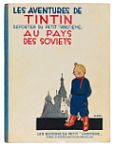The Sotheby’s auction house organized the Bande Dessinée – Comics auction in Paris on July 04, 2012. The event consisted of 95 emblematic artists’ lots of what is also known as “the Ninth Art”, and it was managed by the famous comic book specialist, Jean-Marc Thévenet. From the total of 95 lots 68 did not attract enough interest to attain hammer price. Included in the lots that remained unsold was the highlight of this diverse sale-a cover of number 43 of the Petit Vingtième from 1932; a precursor of the magazine Tintin, that has an early version of the boy reporter travelling by steamer, an early travel image from Hergé. The lot was priced at 95,000 – 120,000 Euros.
The total sale including buyer’s premium came to € 645,225 with a single lot of an original by Hergé, planche originale L’etoile Mystérieuse, selling for € 234,750. The results fell significantly short of the 2 million EUR or there about that Sotheby’s had estimated the total value of the offering to be. Even if the total sale had exceeded expectations and ended at a $2 million sale, it would still have fallen short of Sotheby’s high end auction sale practices. Some of their contemporary art auctions alone have individual lots selling for $2 million or more. So why would they stage events such as the Bande Dessinée that may apparently put them at a disadvantage? One reason is the competitive rivalry which prevails between auction houses such as Sotheby’s and Christie’s. Even though some of the rare book auctions fail to be cost effective, the auction houses would rather continue to conduct them than let a rival dominate a whole genre. Many times where an entire estate is liquidated, a book sale may be key to winning a profitable consignment contract that usually includes other more profitable items.
The timing for the event also had a lot to do with its lack of interest. Collectors of comics and books in general, except those considered to be in the high end of the market, are not immune from bad economic times. Unlike the high end collectibles that have a following consisting of extremely wealthy individuals, that do not necessarily get impacted by economic cycles, rare books and comics are not for the most part in that league. Despite all of the efforts which Sotheby’s put forth to promote the event as high end art by going back to the history of comics to show how they have enjoyed a close relationship with fine art, the high end buyers simply did not play along. Bad economic times, especially in Europe, seem to have taken their toll on Sotheby’s Bande Dessinée.
Then there was the charismatic specialist in charge of the sale – Jean-Marc Thévenet: A well known editor, comic book writer and television producer in the industry, who curetted a number of successful exhibitions of bande dessinée. He was also the editor of the 1980s magazine Pilote, the comic series “X” between 1984 and 1989, which was published by Futuropolis, and Max magazine between 1989 and 1993. He was also the director of the International Comics Festival of Angoulême (FIBD) from 1998 till 2006, when he was fired by the festival’s president, Dominique Bréchoteau, after rumors spread of a potential Thévenet disloyalty. Despite Thévenet’s brilliant comics career background, it may not have been a good choice on Sotheby’s behalf to put him in charge, given the “disloyal” accusations publicized.
Whether the dismal performance of the event was due to economic, cultural or simply natural market forces, the bottom line is that comics are not yet at a point where they can be staged at an exclusive, successful, high end auction event, at least not like the one that Sotheby’s put together last July. In world circles, with the exception of France and Japan comics are still considered low art. Maybe Sotheby’s problem lied in trying to bring low art to a high end market.


{ 0 comments… add one now }